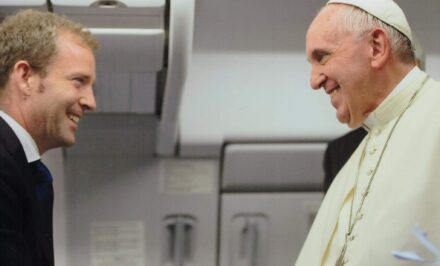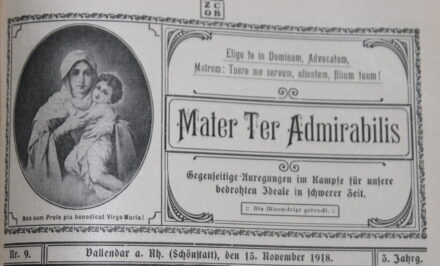
José M. Vidal/RD. He wins people over with just his presence. It is not in vain that the Cardinal of New York, Timothy Dolan, describes himself as “tall, fat and bald.” And, if to his imposing presence he unites a flashy sense of humor, it can be understood that he quickly conquers an audience as he did yesterday at the Universidad de la Santa Croce de la Obra in Rome, in a conference laden with jokes. But within the cabbage, there is a salad of messages such as these: that the Church should not fear the media, but rather win them over by turning the other cheek and that in Francis’ communication there is no marketing, only pure spontaneity and transparency.
![]()
Extroverted, amusing, open, charming. Dolan is by nature a brilliant communicator. Without knowing a lot about the theory of communication, and all he knows he learned by experience, and trusting in his consultants. From that standpoint, he urges all bishops to start up communication teams and to trust in their spokespersons so that it does not happen to them as it happened to him who learned from his mistakes. “In the school of hard knocks, what I learned, I learned blow by blow.”
We bishops should not be frightened nor fear the media
 From that lived experience, the American Cardinal offers a series of clues, simple but pragmatic and essential, for communication in the Church. The first is that “we bishops should not be frightened nor fear the media, knowing they are indispensable for evangelization.” Therefore, in his judgement, the prelates have to accustom themselves to dealing with the media and “ the more we know the media and the journalists, the better they will treat us.”
From that lived experience, the American Cardinal offers a series of clues, simple but pragmatic and essential, for communication in the Church. The first is that “we bishops should not be frightened nor fear the media, knowing they are indispensable for evangelization.” Therefore, in his judgement, the prelates have to accustom themselves to dealing with the media and “ the more we know the media and the journalists, the better they will treat us.”
The second communication clue for the American Cardinal is “take care of the how, even more than the what,” without ever “being afraid to tell the truth, no matter how painful it may be.” And he used examples of priests or deacons who were alcoholics or abusers.
The reason we are criticized, and rightfully so, is because we try to hide things
In these as in other cases, Dolan assures that “the people expect honesty and transparency from the Church.” And he adds: “the reason we are criticized, and rightfully so, is because we try to hide things.” Because, as the new Saint John Paul II would say, “the Church does not fear the truth.”
The third clue, according to Dolan, is to defend the Church. In his judgement, all media have their editorial focus from which they do not stray. Very well then, the fundamental editorial focus for the Catholic media should be the “defense of the Church.” From that standpoint, that they consider “painful” inclusive that the Catholic media is “anti-Church.” And calls to close ranks because to criticize the Church and the bishops, “there are plenty and sufficient other media.”
Dolan acknowledges that “we bishops need the criticism and we need to take it seriously, as long as it is impartial, balanced and courteous.” But, in his judgement, it also must be made clear that “not everything is bad in the Catholic world.”
Turn the other cheek
 In fourth place, the New York Cardinal asked that we do not do to the media what we do not want the media to do to us. That is, “avoid the media stereotypes ,” but be realists because, in his judgement, “there are media which only want to destroy the Church and they attack her constantly.” In that case, Dolan advises “turn the other cheek and do not respond in the same tone.”
In fourth place, the New York Cardinal asked that we do not do to the media what we do not want the media to do to us. That is, “avoid the media stereotypes ,” but be realists because, in his judgement, “there are media which only want to destroy the Church and they attack her constantly.” In that case, Dolan advises “turn the other cheek and do not respond in the same tone.”
And he did not keep from acknowledging that “the immense mayority of journalists are professionals who seek access to the sources of trustworthy information, and if we do not give them to them, they will seek them from those who want to criticize us maliciously.”
Hunger for news and interesting stories
In the fifth place, the Archbishop of New York proposes to use simple angles and take advantage of the “perches” offered by the present in which the media are more interested in religious information. And he gave as an example the attitude of the North American bishops during the last pre-conclave.
“The American Cardinals, when we became aware that there was hunger for news and interesting stories, we convoked press circles. And the journalists responded very well. We celebrated several and we reaped a lot of success and we did it well. But we were criticized by the Curia and even asked us to interrupt the press circles. We did it but we lost a splendid opportunity. Besides, by not informing, many journalists were left only with the rumors and with the information of interest to some of the Italian informers.”
When we want to explain to someone what football is, we do not begin by giving them a class on running, but by taking them to a football game
In sixth place, the Cardinal proposed that Catholic communication has to center on Jesus who is the center of all, in his life and in his experience, and less in the doctrine or in the mysteries of Christianity because, “when we want to explain to someone what football is, we do not begin by giving them a class on running, but by taking them to a football game.
And, as a last clue, Dolan made an invitation to know the audience, those who received the messages and “speak so they can understand us and adapt the message to the public,” aware that “communication is a fundamental ministry in the Church.” Therefore, we have to express the faith “in an attractive and seductive way.”
Short homilies, with hard- hitting phrases, with headlines

And as a perfect example of communication, Dolan referred to Francis. “The Pope is an exceptional communicator because he is a friendly, humble, and intimate Pope. And because he always knows what he wants to say and how.” And the Cardinal adds: “In the Pope’s communication, there is no program, nor a marketing campaign, nor consultants who advise him. He does it spontaneously.”
Following the example of the Pope, Dolan suggests that the homilies of the clerics be “short, with hard- hitting phrases, with headlines.” And for that, they must be prepared.
In the question and answer session, Dolan improvised an influential greeting – like the plan of an American preacher – to the patients of a hospital who were receiving the transmission directly through a radio hospital center.
He stressed that we must “take advantage of all opportunities and go everywhere to evangelize,” inclusive to programs which in the beginning might not seem too advisable. And he concluded saying that to the youth we must “fling the entire Christian message at them, also and especially, that of virtue, sanctity and perfection because they want the entire truth without minimizing it.” And he used the example of professor ‘bone’ who “is usually the one the youth most admire.”
Source: Religión Digital, Spain
Original: Spanish. Translation: Carlos Cantú, La Feria, TX, USA













